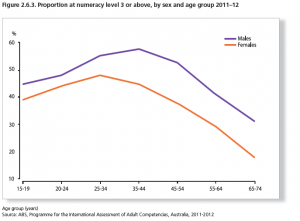Australia’s international position in key school mathematics indicators has declined sharply, according to a confronting report by the Australian Mathematical Sciences Institute (AMSI).
The Discipline Profile of the Mathematical Sciences 2014 highlights strategic trends in school education, higher education, research and research training, and career prospects for graduates. AMSI has identified three areas of critical concern.
1. Within Australian schools around 40 per cent of year 7-10 maths classes are taught without a qualified mathematics teacher.
This figure is roughly three times the international average and twice the estimated rate for year 7-10 science classes, with students in regional and low SES areas bearing the brunt. It comes at a time when 54 per cent of adult Australians have only basic numeracy skills.
“This a national problem hidden from view because teachers are employed by so many public and private jurisdictions. But it will require a national, co-operative solution,” says AMSI Director, Professor Geoff Prince.
2. At the senior level, year 12 enrolments in intermediate and advanced mathematics subjects have dropped 34 per cent over the past 18 years.
These subjects are the gateway to the quantitative professions, from finance, engineering, internet security and biotechnology as well as the mathematical sciences themselves. The steady decline has already had an impact on our future teacher workforce with many schools ceasing to offer advanced maths altogether.
Demand for the mathematically capable workforce far outstrips this falling supply. Our future as a high technology, research driven economy depends on reversing this trend.
And yet remarkably the report shows that the discipline enjoys one of the country’s highest success rates in the competition for research grants.
3. Females are under-represented in mathematics in schools, higher education and the workforce.
Low female enrolments in year 11 and 12 mathematics continue to drive down the participation of women in the quantitative professions. At university level female students make up only 30 per cent of undergraduate and postgraduate enrolments in mathematics subjects, well below the OECD average. Female adult basic numeracy is below that of males around 30 per cent in some age groups.
Professor Prince insists: “Mathematical illiteracy is disabling. An egalitarian society like ours can’t tolerate this endemic disadvantage to women.”
The annual Discipline profile is accompanied by a policy brief with measures to deal with these three critical problems. AMSI calls on the Australian governments to immediately address the urgent shortage of qualified maths teachers. Measures include upgrading existing qualifications for “out-of-field” maths teachers and engaging with school and undergraduate students to become qualified maths teachers.
To kick-start long term improvement AMSI advocates a five year national campaign for mathematics and statistics targeting schools, the higher education sector and business groups to increase participation in advanced mathematics and to address the gender imbalance.
[columns] [one_third]
Teachers teaching in selected areas: qualifications, experience and professional learning activities
For interview
Professor Geoff Prince
Director, Australian Mathematical Sciences Institute
M: 0407 546 336
E: director@amsi.org.au




